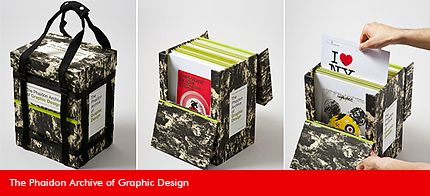
The Phaidon Archive of Graphic Design
The Phaidon Archive of Graphic Design is a book in a box. It is a collection of 500 loose-leaf cards that represent the most influential and innovative graphic designs from around the world throughout history.
There are 15 categories, among them: typeface, logos, ads, magazine covers, money, film graphics, book covers, posers, packaging graphics, etc.
Compiled and researched by experts, and illustrated with up to six images per entry, including rarely seen historical and contextual material, The Phaidon Archive of Graphic Design is the ultimate reference guide.
Born of the traditions of fine art and printing, graphic design is a form of visual communication that seeks to inform, identify or promote through the combination of word and image. But unlike the written word or a work of art, a graphic design operates exclusively in the context in which it will be seen, and mediates between the wishes of the client and the expectations of the public. Moreover, a graphic work is created for mass reproduction.
The field of graphic design, as we know it today, has its roots in two developments: the invention of the printing press in the fifteenth century and the Industrial Revolution of the eighteenth and nineteenth centuries, both of which contributed to the process of graphic reproduction. Today, trade, commerce, communications and culture continue to feed the need for graphic design, and technological developments – most notably the computer – are constantly broadening its possibilities. Of all the arts, graphic design comes closest to our contemporary daily life, as we interact with graphic design on an almost continuous basis.